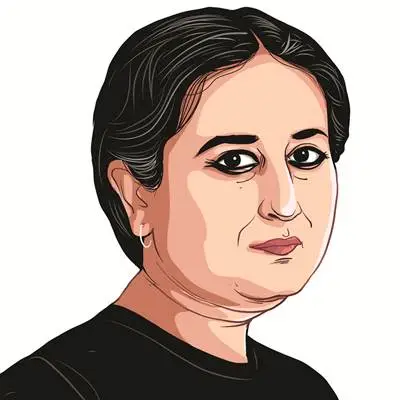Opinion Vandita Mishra writes: Prime Minister Modi’s imagined communities
Countering them with encompassing ideas and a more expansive imagination is the Opposition’s challenge ahead of elections, more than seat-sharing
 PM Modi at the Opening Ceremony of the 141st IOC Session, in Mumbai on Saturday. (PTI Photo)
PM Modi at the Opening Ceremony of the 141st IOC Session, in Mumbai on Saturday. (PTI Photo) Dear Express Reader,
The week began with the announcement of the election calendar for five states next month. It ended with Prime Minister Narendra Modi throwing India’s hat in a global ring. India is eager to host the 2036 Olympics, it is the “age-old dream and aspiration of 140 crore Indians”, he said.
It may well be that the International Olympic Committee, which looks at multiple factors, from the socio-economic and geo-political to transport infrastructure, will look askance at India’s bid. It may be that playing host to the mega sports event figures spectacularly low, or not at all, on the Indian people’s list of priorities as they go about their daily living and dreaming.
Yet the PM’s statement is interesting — not because it captures a truth, or doesn’t, but because it draws a connection between the aam aurat/aadmi and a larger event, or grand whole. And because this is what the PM does so very often. Ahead of the new round of assembly polls, it also gives clues to his and his party’s upcoming pitch.
On the BJP’s menu will be the Big and the Beautiful — from India landing on the Moon to India welcoming the G20, from getting the ambitious women’s reservation bill passed in a brand new Parliament building to a tantalising Olympic straw in a future wind. And between the recent past and a distant horizon, a temple. The “bhavya (magnificent)” Ram Mandir is set to be inaugurated in Ayodhya next year in January.
For the Opposition, which has recently united, more or less, behind the demand for a caste census, on the heels of Bihar’s caste survey, this frames a challenge: Parties opposing the BJP will need to project their demand in its largest and most encompassing version — social justice for all. They will need to guard against its shrinking into its narrowest form — a division and subdivision of the population by bare numbers alone, paving the way for demands for proportional representation and allocation of resources to different groups according to their fixed numerical strength.
Parties of the Opposition will have to find the language and the conviction to point out that numbers are necessary but they are not necessarily divisive. That, read alongside indicators of backwardness, they are essential to counting in — to bring in groups that have been left out or relegated so far by politics and policy. And that, to address this backwardness, the policy of caste-based reservation is only one among the several interventions that are needed.
In other words, while the case for counting caste is so obvious that it doesn’t really need to be made, the Opposition’s work is far from done.
It is evident that caste must be counted in a country where it is quite literally etched in the ground in villages where houses are clustered according to the caste identities of those who live in them, in politicians’ calculations that depend crucially on unofficial caste estimates, and in the caste-based policy of affirmative action implemented by the state. But what remains to be done, still, is to show how counting caste also contributes to the health and well-being of the larger whole, by addressing the needs and concerns of the parts.
That is, even as the Opposition uses the demand for a caste census strategically, to puncture and break up the BJP’s Hindutva monolith, it must also find ways of adding things up again.
Its failure to do so is an older one — after all, parties that rode the Mandal wave and came into existence and prominence with the promise of “social justice” in the heartland in the 1990s, be it the BSP, SP or RJD, have consistently failed to join the dots and make larger coalitions even within the backwards, refused to make common cause, or to forge wider platforms and solidarities.
They will have to do so now. Because now they are up against a Modi-led BJP which constantly imagines and projects larger communities based on Hindutva, and aspiration, and national pride/security. To be sure, its imagined communities have built-in closures and exclusions, crucially of the Muslim minority. They also have embedded inequalities. It is also true that be it the narrative of India-on-the-rise or India-welcomes-the-world, there is fiction in their making, and they count on a suspension of disbelief. They are also a diversionary tactic, to draw attention away from more uncomfortable concerns and issues.
But for the Opposition, just pointing to the holes in the BJP’s imagined communities is not going to be enough. It needs to present to the people big aggregative ideas of its own, and invite voters into its own imagined communities.
As it goes into this round of assembly polls, then, beginning next month, and ahead of the big contest in 2024, creating this shared sense of belonging will be the Opposition’s most arduous challenge, not seat-sharing.
Till next week,
Vandita
***
*PR Kumaraswamy, “Israel’s moment of reckoning”, October 9
*Bernard Haykel, “A straw in the whirlwind”, October 10






